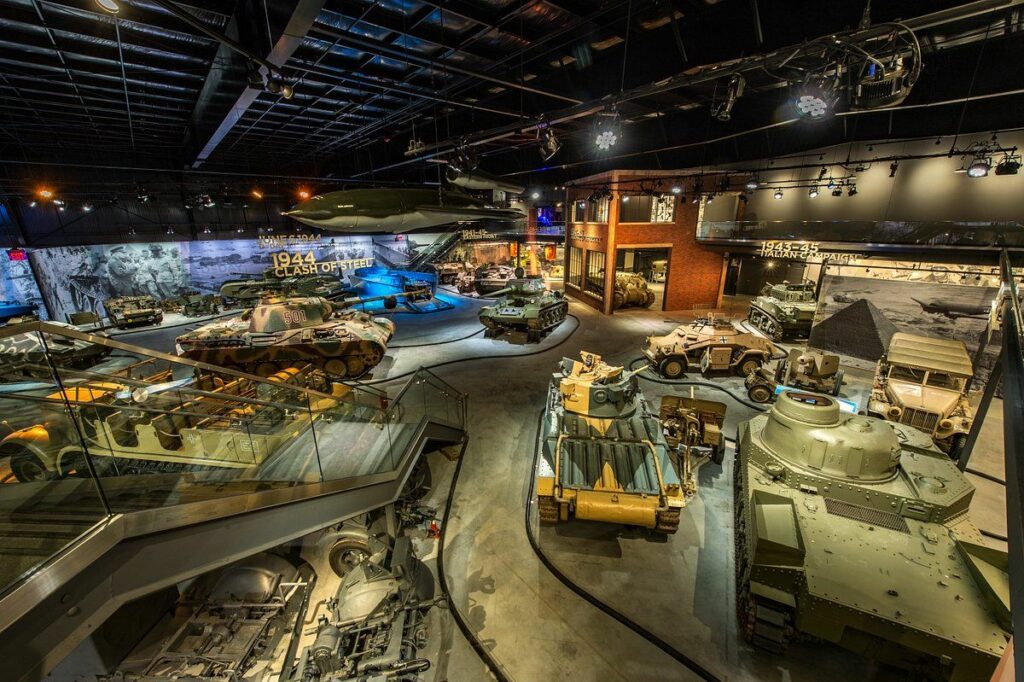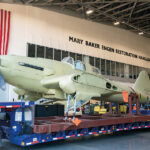Over the past five decades, the Collings Foundation has established itself as one of the world’s finest collections of vintage military aircraft and vehicles. Part of their ethos has involved restoring these artifacts to operational condition – indeed until relatively recently, many of their aircraft were regular participants at air shows across the United States and Canada. They became especially famous for the Wings of Freedom Tour which saw several of their more prominent aircraft barnstorm around North America, offering a closeup view of WWII combat aircraft to the public and even flight experiences to those fortunate enough to afford them.

However, for a variety of reasons, the organization has undergone significant changes of late. While the tour had been on hiatus for some time, the Collings Foundation announced its formal closure earlier this year and that they would be transitioning into a different phase of operations. The majority of the Collings Foundation’s active fleet of aircraft will now join others on static display within their American Heritage Museum (AHM) facility located in Stow, Massachusetts.
To learn a little more about these changes and what lies ahead for the museum, Vintage Aviation News’ publisher, Moreno Aguiari, sat down with the organization’s CEO, Rob Collings, in early April. The following article covers their conversation, lightly edited for clarity.

MA: Can you tell me a little about the Collings Foundation’s decision to focus on the Museum?
RC:“The Collings Foundation always had a long-term plan of becoming a museum from the touring part of what we did. Initially, when we started the Wings of Freedom Tour, it was a five-year plan – and we went 30 years!
The idea was just to get it out there for these World War II veterans to be able to see their airplane, again… to come out and visit and share it with their kids and grandkids. And it took on a life of its own, and went a whole lot longer.”
MA: That makes sense. Can you talk a little about what prompted the shift away from touring your warbirds?
RC: “There have been a lot of changes in how we can operate these aircraft, but also how we can best educate the public. Our mission has shifted too. [Initially] the majority of the people out there [at tour events] were World War II veterans… We were doing it for them and honoring them, [but] now we’re doing it – unfortunately – for the memory of them, because they’re not here anymore. Twenty years ago, when there was a B-17 and a B-24 on the ramp, there would’ve been 20 veterans there at any point in time… If you want to hear stories about what it was like to be a warbird pilot or … the bombardier, or anything like that, they were there to do that, and give you that history lesson from the guy who [actually] made the history.
Today, meeting a World War II veteran is extraordinarily rare, unfortunately. We just lost the very last survivor of the USS Arizona on the 1st [of April]. You and I have had a chance to meet people like the Doolittle Raiders [but] they’re all gone now. So, you look at all those of the Greatest Generation – where we’ve been fortunate enough to meet them and hear their stories; the next generation no longer has that same opportunity.
“[Therefore] we have to create an opportunity where people can understand more about the stories – the human stories – which is really what these artifacts, whether they’re aircraft or tanks, are telling. And we feel the best environment for that is in a museum… where we can convey those stories. Where 20 years ago or [even] 10 years ago, the guy would’ve been sitting beside the warbird and telling you about it… we’re now going to have to explain a lot more.
So we will be going to more immersive museum environment… it has to be immersive nowadays, as it can’t just be aircraft or tanks lined up with signs in front of them. You have to really tell the stories of why they’re important and the sacrifices that were made. That’s the direction we’re going. And that’s what is going to be best for the long-term preservation [of the artifacts] and the education of future generations.”

MA: What we all want to know now, of course, is whether the Collings Foundation will continue flying any of their aircraft, even if only from Stowe, and if so, what vision do you have in moving forward.
RC: “We are going to keep a certain number of aircraft flying for our own events and for some more localized type events… [but] we will not be going back to the nationwide touring of the Wings of Freedom Tour.
We started (in the last couple of years) holding aviation events here [in Stowe]… bringing out certain aircraft. The L-birds are going to be the warbirds, because they’re so easy to operate, and they fit in with a lot of the storylines we’re doing. So having ‘Rosie the Rocketeer’ [the rocket carrying Piper L-4] and the Fieseler Storch flying during the World War II reenactment is a common thing. We also have an aviation weekend where we bring out certain aircraft and we’re able to get a little more in detail with people, to have almost like the a Warbirds in Review at Oshkosh.
You talk about them, and people can really learn more about, them… it’s not just, well, ‘Here’s an airplane flying by,’ but ‘why is this airplane important?’ – ‘Well, this Waco survived Pearl Harbor,’ so it’s got a story that we want to get out there.
We’ve [also] been operating the World War I aircraft. We are continuing to operate some of the jets – in fact, our Me 262 flew in the Wings Over Houston Air Show. The F-100 [Super Sabre] is almost back, ready to fly again. And then, we’ll have a few of the fighters… we’ll be rotating them through. So, we’ll have some of those out there this year. And then, we hope next year that the PBY will be up at Oshkosh… It’s a very, very historic airplane.”
MA: Since you mentioned Oshkosh… are you eventually planning to take some of the airplanes to air shows, or are you envisioning something like a Warbirds in Review style event where you’ll be flying the airplanes locally?
RC: “I think we’re going to have a combination, but we’re [only] going to be operating the aircraft here that are suited for this, right now.
The Pacific reenactment will be one of them. The World War II reenactment in October will be another… and then, we will have an aviation weekend. So. We have three very different events planned out with flying here this year. [Also] we are planning on bringing an airplane up to Burlington, Vermont for… an air show up there. So, we will consider doing some more localized air shows, but we’re not going to be doing many of those. [But] on the Oshkosh front, as I mentioned, the PBY is something we’re planning on for 2025, as our goal is to have that completed and up there.”

MA: That sounds great… Shifting gears a little. With the Foundation’s recent changes, I was wondering whether you might share some of your personal insights regarding the organization’s extraordinary history, the highlights of your time with the team, and your hopes for the organization’s future, going forward.
RC: “I’ve been so blessed and honored to have so many opportunities in the aviation world to fly different aircraft, but to also meet the veterans. I have a picture sitting here on my desk of Dick Cole and I in the B-25… I got a chance to fly a B-25 with Dick Cole. That will always be a highlight memory for me. It’s really these veterans, which has made it so very, very special.
Today, I find it very special with these younger generations now that are coming up and taking an interest in it. I did an interview the other night with this sixth grader. He’s working on a school project on the Arsenal of Democracy, what life was like in America with production of these aircraft, and so forth? And boy, this kid had some great questions… You meet these younger kids – boys and girls – who are very, very knowledgeable on this [WWII] and share that passion, and that makes it incredibly special, to be able to pay it forward a little bit.
I feel we have a really big responsibility with these veterans… they’ve entrusted to us to keep their story alive and keep telling their story of what it was like. Flying a desk is nowhere near as much fun as flying a B-24, and I’ll always miss that. I’m really, really excited about the future direction that we have here though, and creating this new wing of the museum for the aircraft, and what we have already built here with the American Heritage Museum – which is more land war related – It’s been phenomenal! We’re going to be celebrating [the Museum’s] fifth birthday here in a month… the first five years were special. The next five years look even more incredible.”
MA: That’s awesome! It’s been a fascinating conversation – thank you!
———————————————————————————————————————
Vintage Aviation News wishes to thank Rob Collings for taking the time to talk with us and wishes the Collings Foundation much success in this new phase of its operations. We feel sure our readers will appreciate the details we have been able to share here and look forward to what the future holds in store for this important organization!




























